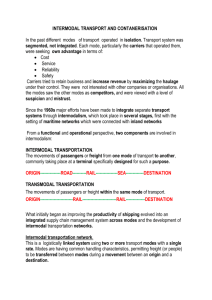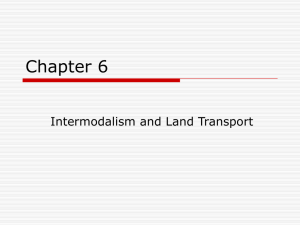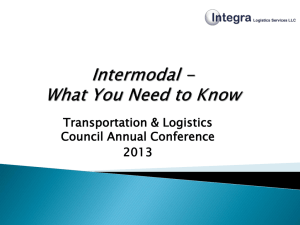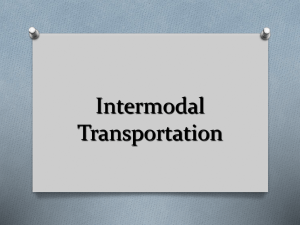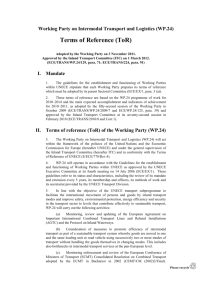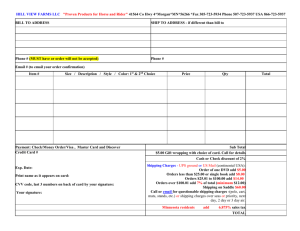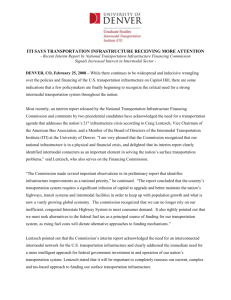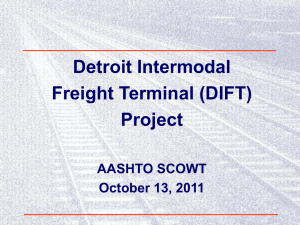Chapter 6 Intermodalism and Land Transport
advertisement
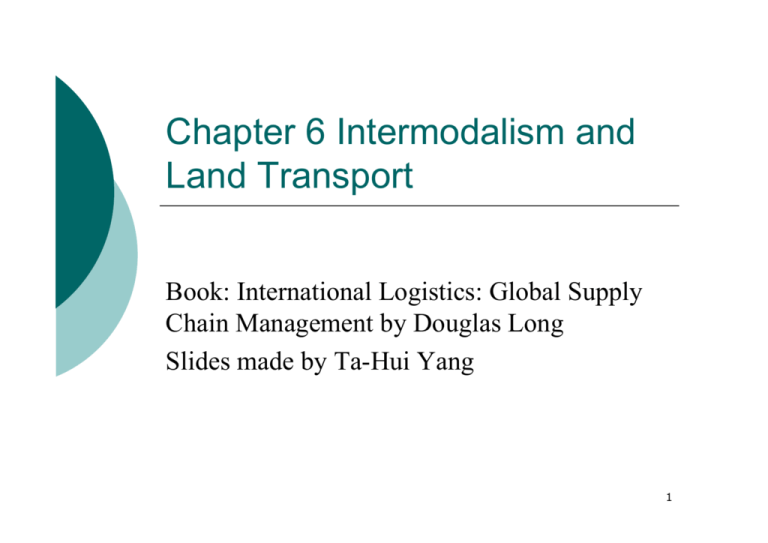
Chapter 6 Intermodalism and
Land Transport
Book: International Logistics: Global Supply
Chain Management by Douglas Long
Slides made by Ta-Hui Yang
1
Outline
{
{
{
{
{
{
{
What is intermodalism?
Intermodal equipment
Managing intermodal transport
Roadway transport
Railroad transport
Inland shipping
pipelines
2
1. Intermodalism
{
What is intermodalism?
z
z
z
A system of coordinating different modes of
transport for a shipment
One of the most revolutionary developments in
logistics in this century
This point is not that multiple modes are being
used, but that they are coordinated so one leg of
the journey is coordinated with the next
3
1. Intermodalism
{
Containerization
z
z
z
z
z
Containerization is the difference between just
multimodalism and true intermodalism.
Intermodalism is most commonly understood as the use of
intermodal containers in a coordinated shipment using
multiple modes of transportation
The important thing about containerization is that the
equipment adheres to the same standards worldwide
The most common modes of transport in an intermodal
movement are trucking, rail, and ocean shipping
Air cargo has intermodalism, but the containers are in air
cargo are very different
4
1. Intermodalism
{
Benefits of intermodalism
z
z
z
z
{
Security
Safety
Efficiency
Speed
Consequence of intermodalism
z
z
The ports are larger, but fewer
The trade lanes handle more cargo, but the
number of trade lanes has decreased
5
2. Intermodal Equipment
{
Cargo container
z
z
The basic element of intermodalism
Size
8 feet wide, 8 feet 6 inches high
{ Majority are 20 feet long or 40 feet long
{ Also come in 45 feet long, or 48 feet long, and few
others, but not conform to the universal standards
{
6
2. Intermodal Equipment
{
Cargo container
z
z
z
z
Low value cargo tends to move in 40s, it is more
important to keep costs low.
Higher value cargo tends to move in 20s.
Heavy cargo tends to move in 20s, because the
weight limit
A trend toward more use of 40s
7
2. Intermodal Equipment
{
Types of containers
z
z
z
z
z
z
z
z
Dry
Open top
Flat rack
Platform
Refrigerated
Live animals
Tank
Bulk
8
2. Intermodal Equipment
{
Cranes
z
{
Used at ports to pick up and handle the containers
TEUs and FEUs
z
z
z
The measurement of containerized volume
Twenty-foot equivalent units, TEUs
Forty-foot equivalent units, FEUs
9
3. Managing Intermodal Transport
{
Cooperation and coordination
z
z
z
The most important aspect of intermodalism is
not the equipment, but the operating and
management issues
Intermodalism requires the coordination of
multiple carriers.
Intermodalism requires cooperation and
coordination among a diverse group of companies
on a level that is rarely seen in other industires.
10
3. Managing Intermodal Transport
{
What are intermodal companies?
z
z
z
z
Sometimes they are asset-based carriers, such as a shipping
company that expands into providing intermodal service.
There are companies that do not control any assets, but
only provide intermodal services. They coordinate
shipments between the other carriers.
One distinctive thing about intermodal carriers is their
sophisticated information system.
They need to process a lot of information, under time
pressure and in coordination with other carriers.
11
3. Managing Intermodal Transport
{
Intermodal traffic patterns
z
z
{
There is a lot of required infrastructure to handle
intermodal cargo.
Usually a few major trade lanes, and many minor
trade lanes.
Equipment balance
z
z
Problem of handling empty containers.
One way to deal with equipment balance issues is
to lease containers instead of using one’s own.
12
4. Roadway Transport
{
{
{
{
Trucking is an indispensable part of almost every
shipment, both domestically and internationally.
It is an important link in the intermodal chain, but it
is also used in some regions for international trade.
Its role in intermodalism is to link the ocean port or
rail yard with the local origin or destination.
Trucking is also used for some international
shipments, and of course fro non-intermodal
shipping.
13
4. Roadway Transport
{
{
{
{
Trucking has low entry requirements.
Of all the different modes, this has the lowest entry
costs.
There are relatively many players in the field, which
creates a highly competitive market.
One of the newer developments is shipper-owned
fleets offering contracts to other companies. They
decide to offer trucking services to other shippers,
maybe during their slow season, or maybe to earn
extra maney.
14
4. Roadway Transport
{
regulations
z
z
z
Every transportation mode is influenced by
regulations
Trucking is more influenced by local rules, such
as speed limits, registration and so on.
The longer the trip, the more legal jurisdictions it
passed through. This creates a strong disincentive
for long distance trucking.
15
4. Roadway Transport
{
{
{
Safety issues are more important with road
transport than any other mode.
In 1997, there were 711 fatalities by trucks in
the US, which is low considering this is a
very safe environment.
In other countries, truck-related accidents are
much higher.
16
4. Roadway Transport
{
Road capacity
z
z
{
Measured by a passenger car equivalent (PCE)
On level roads a truck may be only 1.2 PCE. But on
curving, mountainous roads the same truck can be four
PCEs.
Weight laws
z
z
z
z
Partly for safety reasons, and partly because roads can only
stand a certain amount of weight.
Road damage is based on weight per axle, know as
equivalent standard axle load, or ESAL.
The damage drops off exponentially.
Pavement thickness also varies exponentially.
17
5. Railroad Transport
{
{
{
{
{
Railroad are best for large loads going long distances.
Rail is preferred for loads over 30000 pounds over
distances exceeding 300 miles.
Rail industry have the high entry barriers.
Railroads have been in steady decline over the past
several decades, mostly due to competition with
trucks.
Tax money pays for roads that benefit trucks, but the
railroad industry has not benefited as much from
public support.
18
5. Railroad Transport
{
{
{
{
There are high fixed costs because of the tracks and
the trains, but there are very low variable costs.
There are also almost no weight or volume
restrictions.
There are restrictions on dimensions. Trains go
through tunnels and bridges, which means that their
load cannot exceed their dimensions.
There tends to be high damage (about 3% of total
tonnage) due to vibrations and shock from steel
wheels on steel track.
19
5. Railroad Transport
{
Piggybacking
z
z
{
{
Container-on-flatcar (COFC)
Trailer-on-flatcar (TOFC)
Railroad service is not nearly as flexible for obvious
reason. They can only go where there is track, and
they only stop at railheads.
Trains are much less dependable in keeping to a
schedule, which is an important part of
intermodalism.
z
z
Truckers: 95% on-time performance
Railroads: 70%
20
5. Railroad Transport
{
{
{
Governments have traditionally kept close
control over the railroad industry for military
and social reasons.
Railroads could not abandon lines just
because they were not profitable.
The European railroad system is well
developed.
21
6. Inland Shipping
{
{
{
{
Inland shipping includes rivers, lakes, and canals.
The ships and their service are very different from
maritime (ocean) shipping.
There is a gray area between coastal shipping, which
is in some ways like inland shipping but is in an
ocean.
The fundamental difference is that the service is
mostly domestic for coastal shipping, so it is similar
to inland shipping.
22
6. Inland Shipping
{
One of the biggest limitations is geography.
z
z
z
z
{
{
{
Rivers may be too shallow
Depth changes with the shifting mud and sand
Seasonal variation can create problem
Water freeze
Inland shipping companies have low fixed costs since they do
not need to pay for the right-of-way, and government usually
pays for dredging and navigational aids.
The vessels are much more expensive than trucks, but not very
different from trains, and less than ocean ships.
The biggest competition is railroads and pipelines.
23
6. Inland Shipping
{
Few areas that have the majority of inland
shipping
z
z
z
z
z
US Great Lakes
Russia’s great rivers
Europe’s river system
Mississippi River
China’s great rivers
24
7. Pipelines
{
{
{
{
{
{
Require very high investment, but with very low
variable costs.
One unique thing about pipelines is that the cargo
only moves in one direction, with rare exceptions.
Cargo safety is a strong point, with low loss and
damage.
Pipelines are very dependable, requiring low
maintenance and are not affected by weather.
Pipeline cargo is slow for a storage function.
There is very limited accessibility since the cargo
can only be delivered and accessed at certain places.
25
7. Pipelines
{
{
Piped commodities are considered bulk.
The commodities carried in pipes are quite
limited.
z
z
{
Petroleum dominates the list.
Coal slurry
Larger pipes are much more cost effective
than smaller ones. There is slight friction the
liquid and the inside of the pipe.
26

